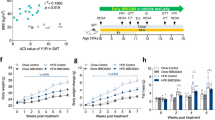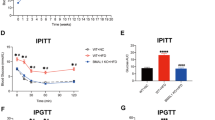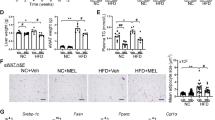Abstract
Peroxisome proliferator-activated receptors (PPARs) are key mediators of energy homeostasis, and lipid and glucose metabolism that exhibit circadian expression. PPAR activating drugs are used clinically as lipid and glucose-lowering drugs. We evaluated the effect of long-term (11 weeks) PPARα and PPARγ activation using bezafibrate and rosiglitazone, respectively, on metabolism, locomotor activity and feeding rhythms of non-obese mice. We found that bezafibrate, but not rosiglitazone, led to no weight gain and a slight weight loss with reduced epididymal fat pads. Although rosiglitazone had a minor effect on 24-h food intake rhythm, bezafibrate treatment was accompanied by increased amplitude and an advanced acrophase of the 24-h feeding rhythm. Similarly, unlike rosiglitazone, bezafibrate treatment was accompanied by a significantly advanced acrophase of locomotor activity rhythm under constant darkness conditions. As disrupted circadian rhythms lead to obesity, PPARα activation can serve as a clinical target for the modulation of both circadian rhythms and metabolism.
This is a preview of subscription content, access via your institution
Access options
Subscribe to this journal
Receive 12 print issues and online access
$259.00 per year
only $21.58 per issue
Buy this article
- Purchase on Springer Link
- Instant access to full article PDF
Prices may be subject to local taxes which are calculated during checkout


Similar content being viewed by others
References
Reppert SM, Weaver DR . Coordination of circadian timing in mammals. Nature 2002; 418: 935–941.
Froy O . Metabolism and circadian rhythms—implications for obesity. Endocr Rev 2010; 31: 1–24.
Turek FW, Joshu C, Kohsaka A, Lin E, Ivanova G, McDearmon E et al. Obesity and metabolic syndrome in circadian Clock mutant mice. Science 2005; 308: 1043–1045.
Charoensuksai P, Xu W . PPARs in rhythmic metabolic regulation and implications in health and disease. PPAR Res 2010; 2010: 243643.
Oishi K, Shirai H, Ishida N . CLOCK is involved in the circadian transactivation of peroxisome-proliferator-activated receptor alpha (PPARalpha) in mice. Biochem J 2005; 386: 575–581.
Canaple L, Rambaud J, Dkhissi-Benyahya O, Rayet B, Tan NS, Michalik L et al. Reciprocal regulation of brain and muscle Arnt-like protein 1 and peroxisome proliferator-activated receptor alpha defines a novel positive feedback loop in the rodent liver circadian clock. Mol Endocrinol 2006; 20: 1715–1727.
Shirai H, Oishi K, Kudo T, Shibata S, Ishida N . PPARalpha is a potential therapeutic target of drugs to treat circadian rhythm sleep disorders. Biochem Biophys Res Commun 2007; 357: 679–682.
Oishi K, Shirai H, Ishida N . PPARalpha is involved in photoentrainment of the circadian clock. Neuroreport 2008; 19: 487–489.
Wang N, Yang G, Jia Z, Zhang H, Aoyagi T, Soodvilai S et al. Vascular PPARgamma controls circadian variation in blood pressure and heart rate through Bmal1. Cell Metab 2008; 8: 482–491.
Bligh EG, Dyer WJ . A rapid method of total lipid extraction and purification. Can J Biochem Physiol 1959; 37: 911–917.
Sherman H, Frumin I, Gutman R, Chapnik N, Lorentz A, Meylan J et al. Long-term restricted feeding alters circadian expression and reduces the level of inflammatory and disease markers. J Cell Mol Med 2011 (in press).
Barnea M, Madar Z, Froy O . High-fat diet delays and fasting advances the circadian expression of adiponectin signaling components in mouse liver. Endocrinology 2009; 150: 161–168.
Krysiak R, Okopien B . Effect of Bezafibrate on monocyte cytokine release and systemic inflammation in patients with impaired fasting glucose. J Clin Pharmacol 2011; 51: 1459–1467.
Author information
Authors and Affiliations
Corresponding author
Ethics declarations
Competing interests
The authors declare no conflict of interest.
Rights and permissions
About this article
Cite this article
Gutman, R., Barnea, M., Haviv, L. et al. Peroxisome proliferator-activated receptor α (PPARα) activation advances locomotor activity and feeding daily rhythms in mice. Int J Obes 36, 1131–1134 (2012). https://doi.org/10.1038/ijo.2011.215
Received:
Revised:
Accepted:
Published:
Issue Date:
DOI: https://doi.org/10.1038/ijo.2011.215
Keywords
This article is cited by
-
Nutrients, Clock Genes, and Chrononutrition
Current Nutrition Reports (2014)



